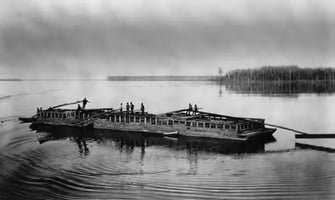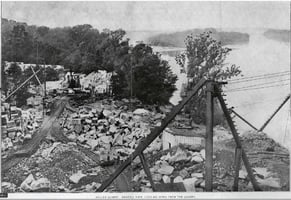From early Indian water navigation in canoes, to settlers traveling downriver in flatboats that...
Tuscumbia Landing

Tuscumbia Landing: A Gateway to the West
Tuscumbia Landing, a historic port site located near downtown Sheffield, Alabama, played a pivotal role in the nation's history. Situated on the Tennessee River, this landing served as a vital transportation hub during the 19th century, connecting the region to the broader American frontier.
Tuscumbia Landing: A Trail of Tears Landmark
Tuscumbia Landing holds a somber place in American history as one of the first sites on the Trail of Tears National Historic Trail System. During the Indian Removal period, thousands of Native Americans, including the Cherokee, Muscogee Creek, and Choctaw tribes, were forced to leave their ancestral lands and relocate to the Indian Territory in Oklahoma. The Tuscumbia-Courtland-Decatur Railway, which ran through Tuscumbia Landing, was used to transport these Native American detachments to the landing, where they would then board boats and continue their journey down the Tennessee River.
Tuscumbia Landing: A Hub of Commerce and Transportation
Beyond its role in the Trail of Tears, Tuscumbia Landing was also a bustling commercial center. Established in 1824 at the mouth of Spring Creek, the landing served as a transfer point for goods transported by steamboat on the Tennessee River. The New Orleans and Tuscumbia Steamboat Company, founded in 1825, connected the Shoals region to major cities like New Orleans and St. Louis.
To facilitate the movement of goods between the landing and the town of Tuscumbia, a horse-drawn railroad was constructed in the early 1830s. This railroad, one of the first west of the Appalachian Mountains, was later extended to Decatur, bypassing the treacherous Muscle Shoals.
Tuscumbia Landing: The Civil War and Its Aftermath
Tuscumbia Landing also witnessed the ravages of the Civil War. In 1862 and 1863, Union forces under the command of Colonel John Basil Turchin and General Grenville M. Dodge inflicted significant damage to the landing, destroying much of its infrastructure. Following the war, Florence emerged as the preferred port in the Shoals region, and Tuscumbia Landing gradually declined in importance.
Tuscumbia Landing: Preserving the Past
Today, Tuscumbia Landing stands as a testament to the region's rich history. The site, which is listed on the National Register of Historic Places, includes the foundations of the original depot, the remnants of a terminal building, and a portion of the old wagon road. Visitors can explore the site and learn about its significance as a transportation hub and a landmark on the Trail of Tears.


